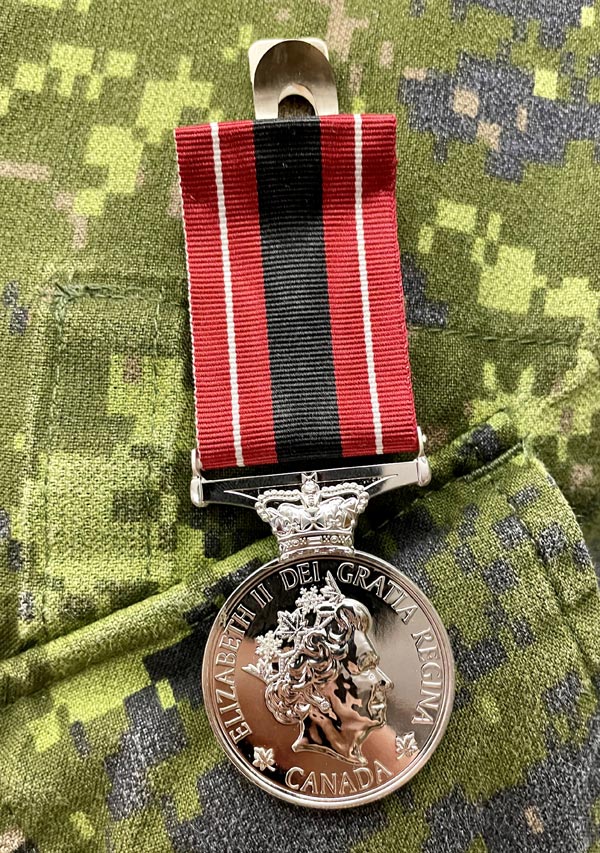



BComd LCol Chris Wood and BRSM CWO Jeremy Abrahamse presented a Sacrifice Medal (SM) to Sgt Vic Law, who works as a Patroller with Base Ops, during an informal ceremony held at Base HQ. Photos Jules Xavier/Shilo Stag
Shilo Stag
BComd LCol Chris Wood and BRSM CWO Jeremy Abrahamse presented a Sacrifice Medal (SM) to a CFB Shilo soldier during an informal ceremony held at Base HQ.
Working for Base Ops as a Patroller, Sgt Victor Law received the medal under the authority of the Governor General and Commander-in-Chief of Canada Mary Simon on behalf of King Charles III, in recognition of wounds he sustained during his multiple deployments to Afghanistan between 2006 and 2008.
The SM was created to provide a tangible and lasting form of recognition for the sacrifices made by members of the Canadian Armed Forces (CAF) and those who work with them who have been wounded or killed under honourable circumstances as a direct result of a hostile action or action intended for a hostile force.
The late Queen Elizabeth II approved the Sacrifice Medal on Aug. 29, 2008.
However, some issues quickly became apparent, especially with regards to the ineligibility of accidental deaths.
The Minister of National Defence at the time asked the Chief of the Defence staff to conduct a review of the existing criteria and make recommendations to the appropriate government committee.
The inaugural presentation ceremony, initially planned for Nov, 12, 2008, was postponed until the conclusion of the review. The review resulted in a broadening of the posthumous criteria of the SM to cover all service-related deaths rather that only those which were the direct result of hostile action.
This change brought the posthumous aspect of the SM in line with the newly amended criteria for the Memorial Cross, Memorial Scroll, Memorial Bar and for inclusion in the 7th Book of Remembrance.
The other aspects of the SM, including the criteria for wounded — which remained linked to hostile action and therefore to the old Wound Stripe which it replaced — the start date and the design of the SM remained unchanged.
It is also awarded posthumously to any member of the CAF who served on or after Oct. 7, 2001, and dies under honourable circumstances as a result of an injury or disease related to military service.
A Commanding Officer (CO) will submit an application through the usual military chain of command for eligible members of their unit.
This honour replaced the Wound Stripe.
The very first recipient of the SM and only recipient of it with bar on Nov. 9, 2009, was Sgt Lance Hooper. He was among 46 recipients who received the SM, including 21 which were posthumous presentations. This group included 1RCHA’s Capt Nichola Goddard, who was KIA on May 17, 2006 while deployed to Afghanistan.
When a death is obviously related to service, the SM will be issued immediately. When the cause of death is not clear, it will only be issued once Veterans Affairs Canada (VAC) has officially determined that the death was related to military service.
In such a case, delays are to be expected before the SM can be awarded.
The SM is a circular silver medal, bearing: on the obverse a contemporary effigy before her recent death of Queen Elizabeth II wearing a Canadian diadem composed of alternating maple leaves and snowflakes circumscribed with the inscriptions “ELIZABETH II DEI GRATIA REGINA” and “CANADA,” separated by small maple leaves; and on the reverse a representation of the statue named “Canada” — which forms part of the Canadian National Vimy Memorial — facing right, overlooking the horizon with the inscription “SACRIFICE” appearing in the lower right half of the SM.
The effigy of Her Majesty represents not only the Queen as Canada’s Head of State (highlighted by the word CANADA and the maple leaves) and Head of the Armed Forces, but also as the FONS HONORIS (the Fount of All Honours).
At the time, the Queen was the only person who could create an official honour in Canada and all Canadian honours are bestowed in Her name. The tradition generally followed since the mid-19th century has been to depict who the medal is from on the obverse, what the medal is for on the reverse, and who the medal is for on the edge.
The Statue “Canada,” designed by architect Walter Seymour Allward as part of the Canadian National Vimy Memorial, symbolizes Canada, the mother of a nation grieving for her fallen. This saddened figure personifies the sorrow for the lives lost and broken by conflict and makes a connection with Vimy, acclaimed by many as the birthplace of the nation and one of the most important military engagements in Canadian history.
She faces a large field representing the loneliness and isolation of mourning but also the future. The statue depicts the figure of a woman, hooded and cloaked, head heavy, with her eyes cast down and her chin resting on her hand. She holds some laurel branches in her right hand: a symbol of peace, honour, and sacrifice.
In future, the medal will feature the effigy of King Charles III.
The SM is fitted with a straight suspension bar ornamented with the Royal Crown.
The ribbon is a watered ribbon, 32 milimetres wide, with a black central stripe (10 mm), flanked by red edges (11 mm each) centered on which are one mm white stripes.
Black represents the mourning of the dead and the shock of the wounds, the red represent the blood that has been spilled and the white, the hope for a better future. Red and white are also the official colours of Canada as decreed by King George V in 1921.
Each subsequent award of the SM shall be indicated by a bar, which shall be attached to the ribbon from which it is suspended, and where two or more bars are attached, those bars shall be equally spaced on the ribbon.
Where the undress ribbon is worn, a silver maple leaf shall be worn centred on the ribbon of the SM to indicate the award of a Bar, a gold maple leaf shall be worn to indicate the award of a second Bar, a red maple leaf shall be worn to indicate the award of a third Bar and a combination of these devices may be worn to indicate the award of more than three bars (example: a red maple leaf and a gold maple leaf representing five bars, etc.).
The SM shall be worn in the sequence prescribed in the Canadian Orders, Decorations and Medals Directive, and in the following manner: on the left breast, suspended from the ribbon described above, between the Royal Victorian Medal and the Gulf and Kuwait Medal.
The SM is made of sterling silver and lacquered to prevent tarnishing. It is manufactured by the Royal Canadian Mint. It is engraved on the edge with the service number, abbreviated substantive rank, initials and surname of military recipients and the forenames and name of civilian recipients.
As of Dec. 31, 2021, 1,050 medals have been issued, including 22 with the bar.


